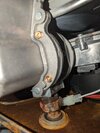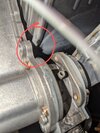We've recently had our condensate pipe replaced and rerouted as it has issues, it was bodged into the gutter and now runs down the side of the house so I can see it.
My boiler is running and I can see a constant flow of water... Not a solid stream but almost, certainly a very fast drip.
Is this typical or something to be looked into? Is water supposed to come out at all normally, or is it more like an overflow?
My boiler is running and I can see a constant flow of water... Not a solid stream but almost, certainly a very fast drip.
Is this typical or something to be looked into? Is water supposed to come out at all normally, or is it more like an overflow?



